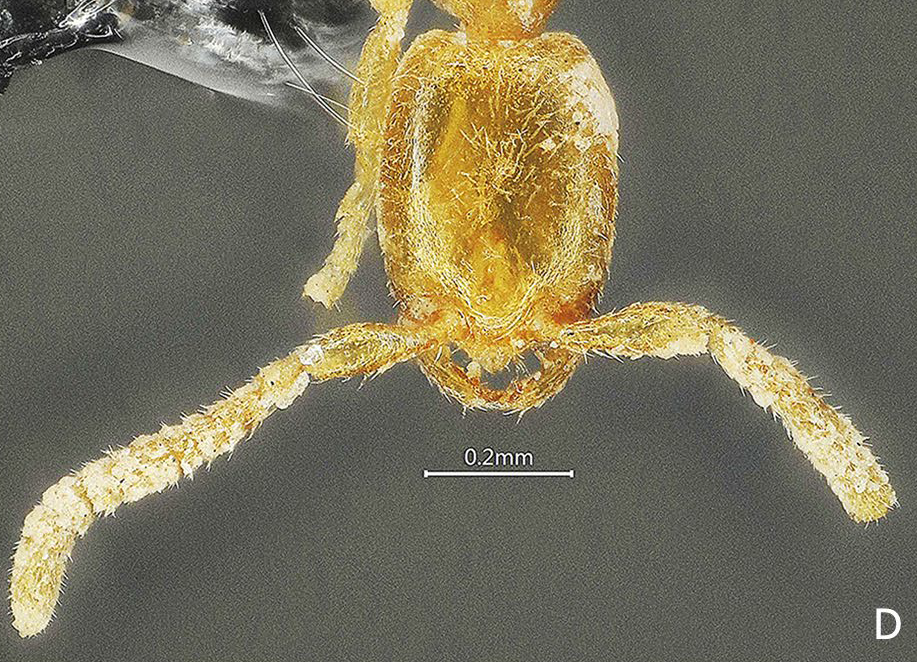Three new species of the subterranean, enigmatic Leptanilla ants
In the recent paper “Three new species of the ant genus Leptanilla (Hymenoptera: Formicidae) from China, with a key to the world species”, the authors Yu-Han Qian, Zheng-Hui Xu, Pei Man, and Guan-Lin Liu review the ant genus Leptanilla using morphological characters of the worker caste and describe three new species including identification key. Here, Phil Hoenle highlights the main points of the work.
A Review by Phil Hoenle

Edited by Patrick Krapf, Alice Laciny, and Beatriz Porthina

The ant subfamily Leptanillinae gained prominence and interest among myrmecologists when phylogenetic data indicated that they belong to an early branching lineage of ants (Rabeling et al., 2008). This special phylogenetic position is associated with many odd features in morphology and life history, and the subfamily still retains major mysteries. For instance, three out of seven genera are only known by males (though they are suspected to actually belong to Leptanilla; Boudinot, 2015; Griebenow, 2021). Leptanilla represents by far the most species-rich lineage within Leptanillinae, and yet they are rarely collected ants with a complicated taxonomy. In their comprehensive research paper now published in Myrmecological News, Qian et al. (2024) describe three new species from China and facilitate their identification with an encompassing Leptanilla key for all species (with a known worker caste). Further, this key is accompanied by sketches of all species, helping to identify their distinguishing characteris.

Leptanilla are hard to find due to a combination of their minute body size, below-ground lifestyle, small colony sizes, and a (presumably) low abundance. Therefore, their current known distribution reflects a combination of undersampling and geographically biased species descriptions. The true range of Leptanilla could potentially encompass an impressive area in most of the tropical and subtropical Old-World and Australia, but there are many huge gaps among country level records (Wong & Guénard, 2018; see AntMaps.org). Very likely, many more species are hiding beneath thick layers of soil, waiting to be uncovered and described (Boudinot et al., 2015).
Qian et al. describe three new species from all over China (Beijing, Yunnan and Shaanxi province), ramping up the total known number of Leptanilla species in this country to eight. Their description now makes China the country with the highest number of known Leptanilla species (this title previously belonged to Tunisia with seven known species). The reproductive biology of Leptanilla ants is also unusual. For instance, queens are worker-like (ergatoid) and wingless (Masuko, 1990). Due to the wingless queens, light trapping (a common method to catch queens and males) only results in Leptanilla males, which has led early taxonomists to a complicated parallel taxonomy where many species have been described based only on male specimens. Therefore, there is potential that males and workers of the same species are falsely described as separate species, an unfortunate obstacle that famously has also plagued other prominent ant groups such as army ants. Qian et al. list a total of 14 species that are known only from males, which poses a challenge for taxonomists that may only be resolved either by more colony collections that include both males and workers, or by DNA sequencing. Qian et al. unfortunately, but understandably so (given the lack of material), do not include a description of males of the new species from China.
Overall, the research in Qian et al. is a step forward toward a better knowledge of this enigmatic genus and serves as an inspiration for the future taxonomic exploration of Leptanillines.

References
-Boudinot, B. E. 2015: Contributions to the knowledge of Formicidae (Hymenoptera, Aculeata): a new diagnosis of the family, the first global male-based key to subfamilies, and a treatment of early branching lineages. European Journal of Taxonomy, 120.
-Griebenow, Z. H. 2021: Synonymisation of the male-based ant genus Phaulomyrma (Hymenoptera: Formicidae) with Leptanilla based upon Bayesian total-evidence phylogenetic inference. Invertebrate Systematics, 35: 603-636.
-Masuko, K. 1990: Behavior and ecology of the enigmatic ant Leptanilla japonica Baroni Urbani (Hymenoptera: Formicidae: Leptanillinae). Insectes Sociaux, 37: 31-57.
-Rabeling, C., Brown, J. M., & Verhaagh, M. 2008: Newly discovered sister lineage sheds light on early ant evolution. Proceedings of the National Academy of Sciences, 105: 14913-14917
-Wong, M. K., & Guénard, B. 2016:. Leptanilla hypodracos sp. n., a new species of the cryptic ant genus Leptanilla (Hymenoptera, Formicidae) from Singapore, with new distribution data and an updated key to Oriental Leptanilla species. ZooKeys, 129.





Note that shortly after I wrote this review there was a big revision of the whole subfamily Leptanillinae by Z. Griebenow published in Zookeys (https://zookeys.pensoft.net/article/107506/). This new work also contains several new species of Leptanilla and both a worker- and male-based key of all known species except the ones described by Qian et al. 2024.